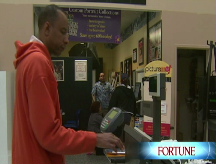The bright spot in a dark economy
Saving is on the rise. That's a long-term good, though it won't help battered job and housing markets.

NEW YORK (Fortune) -- The economic storm pelting the U.S. economy is going to do plenty more damage to already flattened job and housing markets.
But as dark as the next three or four quarters could be, the U.S. economy appears to be undergoing a more lasting, and ultimately uplifting, shift.
Americans who for decades have spent an increasing share of their incomes and taken on more and more debt are now, for the first time in years, saving instead.
The personal savings rate, which measures the amount of disposable personal income that isn't spent, ticked up to almost 3% in the second quarter of 2008, after almost four years below 1%.
While Americans still aren't going to win any awards for thrift - consumers save more than 10% of their paychecks in creditor nations such as Germany and Japan, for instance - the return to saving carries big implications for U.S. economic health.
More saving is good over the long haul, because domestic savings create a pool of money from which companies can borrow to invest in new plants and equipment, creating the jobs that push living standards higher over time.
A growing domestic savings pool could also reduce America's need to borrow money overseas - which would make the U.S. less beholden to foreign creditors who now supply us with hundreds of billions of dollars in financing every year.
Unfortunately, thrift will cost in the short run. Saving more means spending less - which translates into more hard times in retail and other consumer-driven businesses like the auto industry. The latest evidence of the shift came in Wednesday's steeper-than-expected pullback in retail sales. They dropped 1.2% in September, in their first year-on-year decline in six years and only their third drop in the past 16 years. Economists had been looking for a 0.7% drop.
Given that two-thirds of economic activity is consumer spending, today's thrift will exacerbate a general downturn and will weaken the impact of the massive interventions the government has made in the financial markets.
"The breadth of the decline shows a broad-based pullback in consumer spending that will not quickly turn around," writes PNC economist Stuart Hoffman, "even with the arsenal of federal firepower now aimed at the Great Financial Crisis of 2008."
Federal actions such as a $250 billion plan to buy preferred shares in banks, along with a public guarantee of bank deposits and bank debt, are aimed at unlocking credit markets and boosting economic activity. Policymakers have promised to get banks lending again, to restore economic growth that has clearly been ebbing even as government data chalked up modest gains in gross domestic product for the first half of the year.
"This plan is a means to an end," Hoffman says of the Treasury's agreement to make capital injections in banks such as Citi (C, Fortune 500), JPMorgan Chase (JPM, Fortune 500) and Bank of America (BAC, Fortune 500). "The key concept is that reasonably prudent lending should be supported."
But as the economy shows further signs of deceleration - factory production and industrial capacity utilization fell sharply in September, the Federal Reserve said Thursday - the question is who the banks will be lending to. Indeed, merely plying the banks with capital isn't certain to get them lending in a world in which businesses and consumers are trying to reduce their leverage after a long run of credit expansion.
William Cline, a senior fellow at the Peterson Institute for International Economics, notes that the decline of saving in the United States over the past two decades was accompanied by a sharp increase in the rate of bank lending, as consumers cashed in on the appreciating value of their houses.
Bank credit growth, after averaging around 6.5% in the 1990s, spiked to 12% in the four years ended in 2007, Cline says. Meanwhile the U.S. personal saving rate turned negative at the height of the housing bubble in 2005, down from around 7% in the early 1990s.
"We were already on course to have some return to saving," says Cline, who is the author of the 2005 book, "The United States as a Debtor Nation." With the credit crunch making consumer credit scarcer, he adds, and reduced house prices making Americans feel poorer, "We're going to see some more pressure on household spending."
For now, that will mean more pressure on companies that sell their goods to consumers. GM (GM, Fortune 500) and Ford (F, Fortune 500) have traded at multi-decade lows this month as U.S. auto sales slowed to a pace last seen in the early 1990s. Macy's (M, Fortune 500) dropped 12% Wednesday after the department store chain cut its profit forecast, prompting ratings agency Moody's to warn that further problems could prompt a costly credit downgrade.
The government interventions mean deleveraging can continue without the risk of an economic collapse, which is obviously "extremely positive" in the long run, says Ken Kamen, a financial adviser who is president of Mercadien Asset Management in Trenton, N.J. But that doesn't mean the short run is going to be particularly enjoyable, as Wednesday's 9% stock market decline suggests.
Kamen warns his clients that before they make any hasty decisions, they should decide how much stress they can tolerate in their portfolios.
"You don't want to be resetting your financial future while the compass needle is spinning," he says. "You may need to sell assets - but only to the point where you can sleep at night." ![]()
-
 The retail giant tops the Fortune 500 for the second year in a row. Who else made the list? More
The retail giant tops the Fortune 500 for the second year in a row. Who else made the list? More -
 This group of companies is all about social networking to connect with their customers. More
This group of companies is all about social networking to connect with their customers. More -
 The fight over the cholesterol medication is keeping a generic version from hitting the market. More
The fight over the cholesterol medication is keeping a generic version from hitting the market. More -
 Bin Laden may be dead, but the terrorist group he led doesn't need his money. More
Bin Laden may be dead, but the terrorist group he led doesn't need his money. More -
 U.S. real estate might be a mess, but in other parts of the world, home prices are jumping. More
U.S. real estate might be a mess, but in other parts of the world, home prices are jumping. More -
 Libya's output is a fraction of global production, but it's crucial to the nation's economy. More
Libya's output is a fraction of global production, but it's crucial to the nation's economy. More -
 Once rates start to rise, things could get ugly fast for our neighbors to the north. More
Once rates start to rise, things could get ugly fast for our neighbors to the north. More









